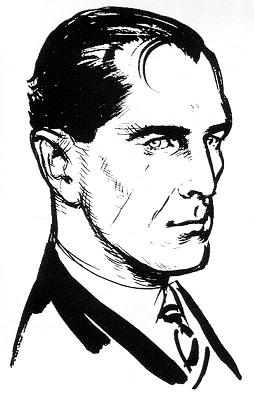
The James Bond series focuses on James Bond, a fictional British Secret Service agent created in 1953 by writer Ian Fleming, who featured him in twelve novels and two short-story collections. Since Fleming's death in 1964, eight other authors have written authorised Bond novels or novelisations: Kingsley Amis, Christopher Wood, John Gardner, Raymond Benson, Sebastian Faulks, Jeffery Deaver, William Boyd, and Anthony Horowitz. The latest novel is With a Mind to Kill by Anthony Horowitz, published in May 2022. Additionally Charlie Higson wrote a series on a young James Bond, and Kate Westbrook wrote three novels based on the diaries of a recurring series character, Moneypenny.
M is a codename held by a number of fictional characters in Ian Fleming's James Bond book and film series; the characters are the current or past Chief of the Secret Intelligence Service, the agency known as MI6. Fleming based the character on a number of people he knew who commanded sections of British intelligence. M has appeared in the novels by Fleming and seven continuation authors, as well as appearing in twenty-four films. In the Eon Productions series of films, M has been portrayed by four actors: Bernard Lee, Robert Brown, Judi Dench and Ralph Fiennes, the incumbent; in the two independent productions, M was played by John Huston, David Niven and Edward Fox.

Felix Leiter is a fictional character created by Ian Fleming in the James Bond books, films and other media. The character is an operative for the CIA and Bond's friend. After losing a leg and his hand to a shark attack, Leiter joined the Pinkerton Detective Agency. The name "Felix" comes from the middle name of Fleming's friend Ivar Bryce, while the name "Leiter" was the surname of Fleming's friend Marion Oates Leiter Charles, the then wife of Thomas Leiter.

Licence to Kill is a 1989 action-thriller film, the sixteenth in the James Bond series produced by Eon Productions, and the second and final film to star Timothy Dalton as the MI6 agent James Bond. It sees Bond suspended from MI6 as he pursues the drug lord Franz Sanchez, who has ordered an attack against Bond's CIA friend Felix Leiter and the murder of Felix's wife after their wedding.
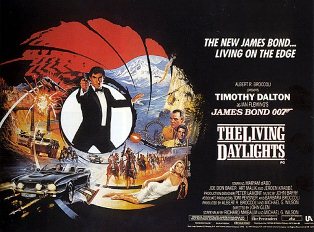
The Living Daylights is a 1987 spy film, the fifteenth entry in the James Bond series produced by Eon Productions, and the first of two to star Timothy Dalton as the fictional MI6 agent James Bond. Directed by John Glen, the film's title is taken from Ian Fleming's short story "The Living Daylights", the plot of which also forms the basis of the first act of the film. It was the last film to use the title of an Ian Fleming story until the 2006 instalment Casino Royale. It is also the first film to have Caroline Bliss as Miss Moneypenny, replacing Lois Maxwell. The film was produced by Albert R. Broccoli, his stepson Michael G. Wilson, and co-produced by his daughter, Barbara Broccoli. The Living Daylights grossed $191.2 million worldwide, and received mixed reviews from critics.

John Bernard Lee was an English actor, best known for his role as M in the first eleven Eon-produced James Bond films. Lee's film career spanned the years 1934 to 1979, though he had appeared on stage from the age of six. He was trained at the Royal Academy of Dramatic Art in London. Lee appeared in over one hundred films, as well as on stage and in television dramatisations. He was known for his roles as authority figures, often playing military characters or policemen in films such as The Third Man, The Blue Lamp, The Battle of the River Plate, and Whistle Down the Wind. He died of stomach cancer in 1981, aged 73.
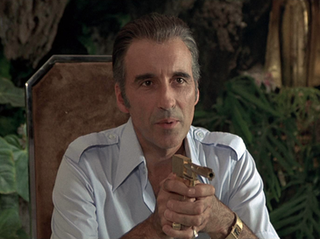
Francisco Scaramanga is a fictional character and one of the main antagonists in the James Bond novel and film version of The Man with the Golden Gun. Scaramanga is an assassin who kills with his signature weapon, a pistol made of solid gold. In the novel, the character is nicknamed "Pistols" Scaramanga and is also called "Paco". In the film, the character was played by Christopher Lee.

Brad Whitaker is a fictional character in the James Bond film The Living Daylights. He was portrayed by American actor Joe Don Baker. Baker also appeared as Jack Wade, Bond's CIA contact, in Pierce Brosnan's first two Bond films, GoldenEye and Tomorrow Never Dies. Steven Rubin describes Whitaker as a "smarmy bad-guy arms trader."

The Man with the Golden Gun is a 1974 spy film and the ninth in the James Bond series produced by Eon Productions, and the second to star Roger Moore as the fictional MI6 agent James Bond. A loose adaptation of Ian Fleming's posthumously published 1965 novel of the same name, the film has Bond sent after the Solex Agitator, a breakthrough technological solution to contemporary energy shortages, while facing the assassin Francisco Scaramanga, the "Man with the Golden Gun". The action culminates in a duel between them that settles the fate of the Solex.

On Her Majesty's Secret Service is a 1969 spy film and the sixth in the James Bond series produced by Eon Productions. It is based on the 1963 novel by Ian Fleming. Following Sean Connery's decision to retire from the role after You Only Live Twice, Eon selected George Lazenby, a model with no prior acting credits, to play the part of James Bond. During filming, Lazenby announced that he would play the role of Bond only once. Connery returned to portray Bond in 1971's Diamonds Are Forever.
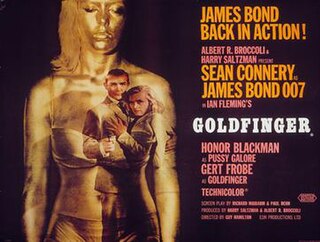
Goldfinger is a 1964 spy film and the third instalment in the James Bond series produced by Eon Productions, starring Sean Connery as the fictional MI6 agent James Bond. It is based on the 1959 novel of the same name by Ian Fleming. The film also stars Honor Blackman as Pussy Galore and Gert Fröbe as the title character Auric Goldfinger, along with Shirley Eaton as the ill-fated Jill Masterson. Goldfinger was produced by Albert R. Broccoli and Harry Saltzman and was the first of four Bond films directed by Guy Hamilton.
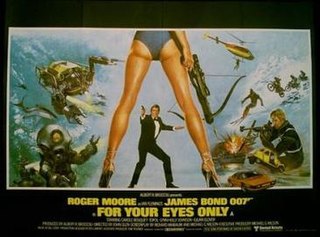
For Your Eyes Only is a 1981 spy film directed by John Glen and produced by Albert R. Broccoli. The film stars Roger Moore as the fictional MI6 agent James Bond, and co-stars Carole Bouquet, Chaim Topol, Lynn-Holly Johnson and Julian Glover.

Dr. No is a 1962 spy film directed by Terence Young. It is the first film in the James Bond series. Starring Sean Connery, Ursula Andress, Joseph Wiseman and Jack Lord, it was adapted by Richard Maibaum, Johanna Harwood, and Berkely Mather from the 1958 novel of the same name by Ian Fleming. The film was produced by Harry Saltzman and Albert R. Broccoli, a partnership that continued until 1975. It was followed by From Russia With Love in 1963. In the film, James Bond is sent to Jamaica to investigate the disappearance of a fellow British agent. The trail leads him to the underground base of Dr. Julius No, who is plotting to disrupt an early American space launch from Cape Canaveral with a radio beam weapon.
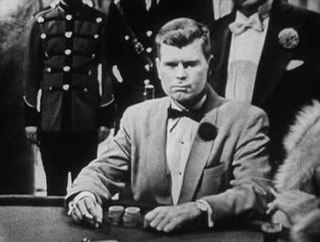
"Casino Royale" is a live 1954 television adaptation of the 1953 novel of the same name by Ian Fleming. An episode of the American dramatic anthology series Climax!, the show was the first screen adaptation of a James Bond novel, and stars Barry Nelson, Peter Lorre, and Linda Christian. Though this marks the first onscreen appearance of the secret agent, Nelson's Bond is played as an American spy working for the "Combined Intelligence Agency".
The James Bond film series is a British series of spy films based on the fictional character of MI6 agent James Bond, "007", who originally appeared in a series of books by Ian Fleming. It is one of the longest continually running film series in history, having been in ongoing production from 1962 to the present. In that time, Eon Productions has produced 25 films as of 2021, most of them at Pinewood Studios. With a combined gross of over $7 billion, the films produced by Eon constitute the fifth-highest-grossing film series. Six actors have portrayed 007 in the Eon series, the latest being Daniel Craig.

The Living Daylights is the soundtrack title for the film The Living Daylights and the eleventh and final Bond soundtrack to be scored by composer John Barry. The soundtrack is notable for its introduction of sequenced electronic rhythm tracks overdubbed with the orchestra – at the time, a relatively new innovation.
The James Bond series of films contain a number of repeating, distinctive motifs which date from the series' inception with Dr. No in 1962. The series consists of twenty five films produced by Eon Productions featuring the James Bond character, a fictional British Secret Service agent. The most recent instalment is No Time to Die, released in UK cinemas on 30 September 2021. There have also been two independently made features, the satirical Casino Royale, released in 1967, and the 1983 film Never Say Never Again.

James Bond is a fictional character created by the British journalist and novelist Ian Fleming in 1952. The character first appeared in a series of twelve novels and two short story collections written by Fleming and a number of continuation novels and spin-off works after Fleming's death in 1964. Bond's literary portrayal differs in some ways from his treatment in the James Bond films, of which there have been twenty-seven in total, produced and released between 1962 and 2021.
A bibliography of reference material associated with the James Bond films, novels and genre.















